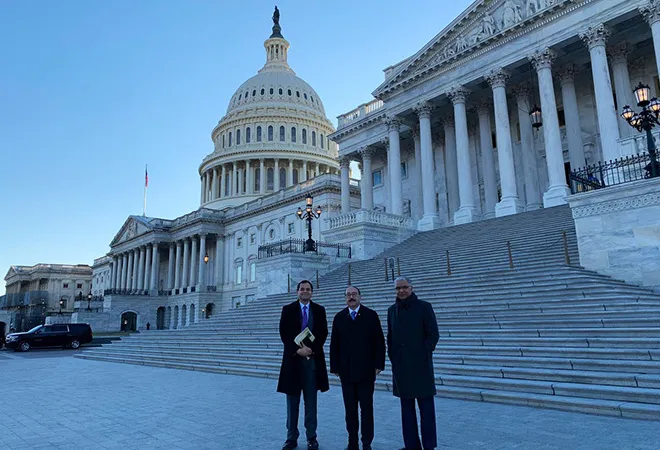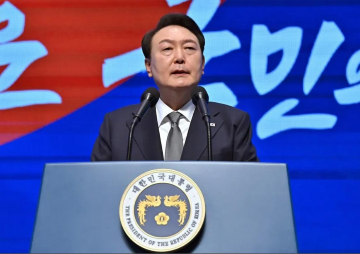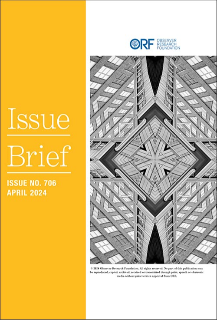
There was avid interest among policy onlookers when news broke out that India could be handed the MNNA status (Major Non-NATO Ally), which is currently afforded to countries such as Japan, South Korea, Israel, Australia etc. It wasn’t a Donald Trump tweet or a White House press release that made this announcement. It was possibly not even talked about during the recent meeting between U.S President Donald Trump and Indian PM Narendra Modi at the sidelines of the G20 Summit. While the two national leaders were busy ironing out differences over trade tariffs and India’s S-400 purchase, the news regarding India’s MNNA status surfaced from a source hitherto less talked about among foreign policy analysts.
The source? A vocal legislative constituency in US Congress that steadfastly works towards bolstering ties between the two countries: the House and Senate India Caucus. The U.S Congress consists of two chambers: the House of Representatives and the Senate (similar to India’s bi-cameral legislature having the Lower House - Lok Sabha and Upper House - Rajya Sabha). A caucus is a grouping of like-minded Congresspersons who strive to speak in one voice and vote consistently on a particular issue. Since their respective inceptions, both the caucuses have played a stellar role in holding together bilateral relations between the two countries.
These two country-specific caucuses were set up to lobby the executive to influence legislation and devote considerable attention in favor of India. Remarkably bi-partisan and diverse in composition, their activity primarily involves tabling amendments for vote and shaping opinion of the policy-makers in the interest of Indo-U.S foreign relations.
After Trump remarked that Modi had requested him to mediate on Kashmir during a press interaction alongside Pakistan Prime Minister Imran Khan, the House India Caucus sprung to India’s defence. In a joint statement, Congressman George Holding and Congressman Brad Sherman who Co-Chairs the Congressional Caucus on India and Indian Americans, asserted that Kashmir is a bilateral issue between India and Pakistan and went on to add that the need for the hour was to combat terrorism and extremism throughout South Asia (obviously in reference to Pakistan). The fact that the congressional caucus clarified its stand speaks of their role as an enduring partner that India can expect in times of executive uncertainty.
Recently there was an attempt by Brad Sherman, along with Tulsi Gabbard, to designate India as a major non-NATO ally. Despite having bi-partisan support and co-sponsors from both sides of the aisle, the amendment did not make it to the House Rules Committee – a fate similar to the corresponding amendment in the Senate, submitted by co-chairs Mark Warner and John Cornyn which also sought to give India NATO-equivalent status for arms sales. The broad concern was over India’s impending purchase of the S-400, which is likely to have contributed to the watering down of the amendment. Moreover, the Foreign Relations Committee has increasingly sought to chip away the contours of the executive authorization of weapons sale through the Arms Control Export Act (AECA). If India had received the MNNA status, then the White House could have notified the sale under the FMS program (Foreign Military Sales) and Congressional approval would have required only 15 days (as opposed to 30). Regardless of the final outcome of the said legislation, the efforts of the caucus are scantily dealt with in foreign policy analysis involving the two countries.
The Congressional Caucus on India and Indian Americans remains the largest country-specific caucus in the US House of Representatives ever since it was established in 1993 under the stewardship of Stephen Solarz, who was one of the few pro-India legislators at that time. The Senate India caucus, on the other hand, was formed in 2004 by Senator John Cornyn and Hillary Clinton, which was the first country-specific caucus and was instrumental in the smooth passage of the Indo-US Civil Nuclear Deal.
During the Clinton and Bush administrations
Given India’s inclination towards the Soviets during the Cold War, anti-India sentiments still remained high among certain US policy makers in the early 1990s. In 1992, Bill Clinton won the Presidential elections with a mandate to steer the economy forward following foreign policy successes under the previous administration. This was the backdrop to the formation of the House India Caucus, with about 50 bi-partisan members.
For much of Clinton’s two terms in office, the Caucus was lobbying extensively to persuade the administration to prevent the sale of F-16s to Pakistan and dissuade slapping sanctions on India for its nuclear program. However, Clinton issued a one-time waiver of the Pressler Amendment (that prevented arms sales to Pakistan for developing their nuclear program) in order to fulfill Pakistan’s purchase order of F-16s.
The turning point took place after the initiation of the Kargil conflict by Pakistan whereby the caucus heavily lobbied the administration to impose further sanctions on Islamabad for the unilateral aggression. Led by Gary Ackerman, the House India Caucus moved an amendment ‘HR 227’ stating that the U.S President was to instruct representatives in IMF, World Bank and ADB to oppose any loan applications from Pakistan, except for food or humanitarian assistance, until it withdraws it forces from the Indian side of the Line of Control. In a major victory for the caucus’ efforts, the amendment passed with 22 votes and the administration read it as a signal that America’s elected representatives had chosen to unambiguously back India in the conflict.
Under George W Bush, the House India Caucus was feeling the pinch courtesy the administration’ efforts to shore up support for Pakistan given the latter’s involvement in counter-terrorism efforts in neighbouring Afghanistan. Although the Congressional Caucus on India had around 124 members by 2001, it was felt that pro-India efforts lacked punch in the Senate where lawmakers have often been indifferent towards India’s concerns.
This inspired the founding of the Senate India Caucus in 2004, whose utility was on full display during the vote on the Indo-U.S Civil Nuclear Agreement. Although Republicans had the required majority in the US Congress and the deal was being backed by the Bush administration, it would still not have ensured the deal's passage. There were deeply entrenched actors within the US State Department and the non-proliferation lobby that opposed the US decision to make India an exception to nuclear regulations. Efforts were also made by Pakistan and China to block it in the Congress.
The Indian Americans, along with leading India Caucus members Gary Ackerman, Frank Pallone, John Cornyn and Indian American organizations like USINPAC, IACPA, IAFPE lobbied to ensure that the 39 members of the India Caucus in the Senate and more than 180 members of the Caucus in the House of Representatives voted for the deal. The domestic political mobilization of Indian-Americans laid the foundation for the increasing influence of the caucus. During the 2004 Presidential election, the caucus began to gain relevance with the Indian American community playing a crucial role in many swing states. In the crucial state of Florida, where Indian doctors supported Bush, Indian Americans may have helped swing the verdict.
However, the caucus has limitations in that it could not affect substantive legislation despite the political and economic clout of the Indian-American community.
Limitations of the Caucus
Therefore, it is more likely that both the House and Senate India caucuses only offer a sense of direction to the administration on foreign policy matters relating to India rather than overly change the course of policy. Moreover, while the caucus had achieved minor wins in its short history, there is still a sense that the President and his advisors still call the shots and regularly overrule the suggestions of congressional groupings. For example, the recent US revocation of India’s GSP status underscores this point. Despite efforts to salvage India’s designation as a beneficiary developing country under the Generalized System of Preferences (GSP) by influential pro-India caucus members including Tulsi Gabbard, Republican Congressman George Holding and Indian-American Congressman Ami Bera, the White House simply delayed the inevitable action; waiting to move forward with it until India’s elections were over. Under Trump, it is becoming increasingly clear that national interests triumph over group or lobby interests and might further lead to reduced congressional activity. However, if the pro-India caucuses wish to replicate the success of the powerful Israeli congressional lobby, there must be a broad, long-term coherence of US strategic interests with India’s national interests. While this is bound to improve given the common threats of China, terrorism and economic inter-linkages, the immediate task of these caucuses is to impress upon the administration about the commonalities and shape opinion in favor of India.
The author is a Research Intern at ORF Delhi
The views expressed above belong to the author(s). ORF research and analyses now available on Telegram! Click here to access our curated content — blogs, longforms and interviews.




 PREV
PREV

